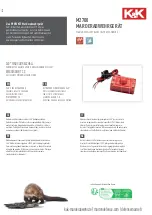
Version Update – March 2003
NANO-C, V3.00 to V3.01
12
Jetter AG
2.4 Monitoring the activities of interfaces
With the help of two special flags per interface, the activities of any connected
communication partner that is communicating with the NANO-C via LCD, PC or JETWay
interface, can be monitored through the application program. This way it can be checked,
whether, for example, there is still a connection to an operating and display module.
Note
Monitoring the interface activity by PRIM via special flag is not possible for user-
programmable interfaces.
The first special flag will be set by the operating system, when a valid telegram has been
received. A monitoring time can be set in a register; it will be started simultaneously with
receiving the telegram. Any further telegram will re-start the monitoring time.
Another special flag can be set by the user. If no valid telegrams are received any more,
both special flags will be reset when the monitoring time has elapsed. As the second
special flag has not been set by the operating system, the user can check whether the
connection had been interrupted for a short time. In this case, the NANO-C would, after
an interruption, reset the first special flag only for a short instance and after this set it
again immediately.
The monitoring time can be defined via register by the user for each interface individually.
By setting the monitoring time to zero, activity monitoring will be switched off.
For activity monitoring, cyclic data exchange on the interface must be active.
If operator panels, such as LCD9, LCD 34, LCD 19, … are used, the monitoring time
should not be set to less than 200 ms. If values smaller than 200 ms are set, errors might
be reported in multi-display mode or in big-sized user interfaces in spite of active
communication.
In process monitoring systems – such as VIADUKT or JETLink, as well as in JetSym –
the interrogation time can either be set or else communication can be stopped altogether.
This must be considered for activity monitoring.
Frames
Flag 2092
Flag 2093
Timeout
Register2957
Application Program:
WHEN FLAG 2092
THEN FLAG 2093
Fig. 2 Monitoring of the LCD interface


































